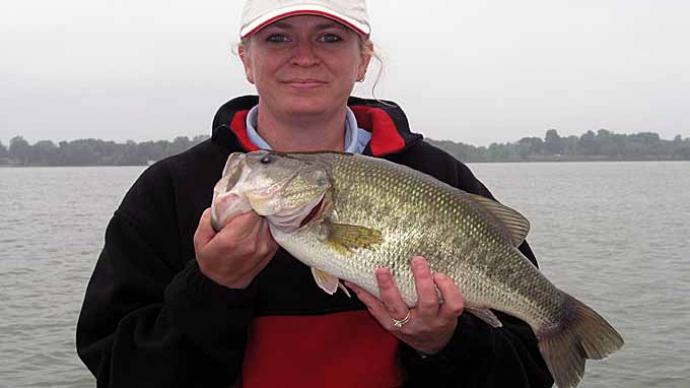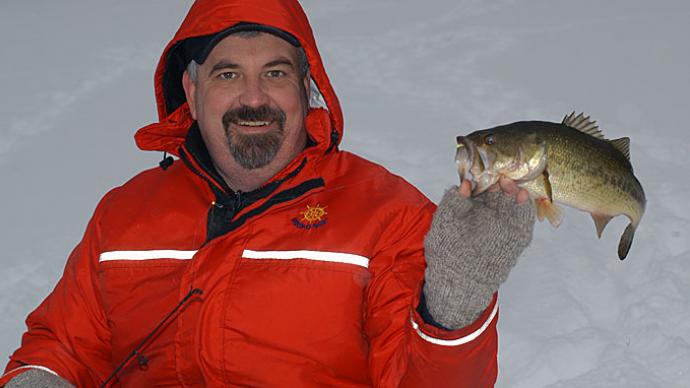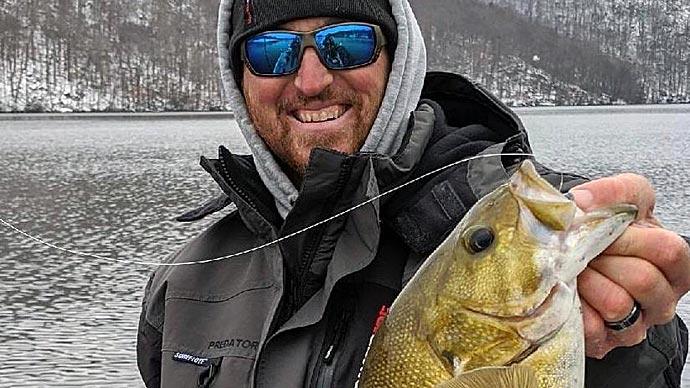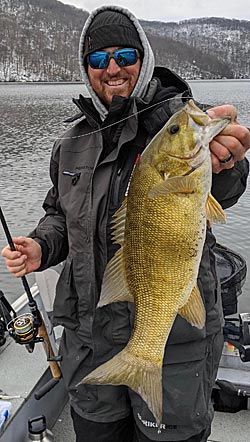
Bass anglers will do just about anything to reach a good spot. They’ll push their boats over sandbars and cut their way through flooded timber. And in the late 1980s, longtime professional bass tournament angler Randy Blaukat swamped his boat to get under a bridge during a Bassmaster tournament on rain-swollen Kerr Reservoir, along the Virginia-North Carolina line. That move proved to be the correct one. He won.
Bassmaster Elite Series angler Paul Mueller puts ice-breaking on that list, too. The Connecticut resident spends plenty of time on the ice chasing panfish each winter. But he goes through it in his bass boat when it’s patchy and too thin to stand on. While he willingly takes advantage of that opportunity, it’s not always smooth sailing. “I was pushing through soft ice, maybe an inch thick,” he said. “If you go too fast, it will cut through a keel guard.”
Just before ice forms, when the water temperature is in the 30s, Mueller said sluggish bass that won’t even chase a slow-rolled swimbait still can be caught. All it takes, he said, is some Freestyling. He developed a light-line technique from his panfish and ice-fishing adventures. Its effectiveness is found in perfectly matched jig heads and soft plastics, giving him a three-punch approach for bass when they are their finickiest. “The whole thing is that you are downsizing,” he said. “It’s crazy how efficient it is.”
Mueller named the technique for its versatility. “You can fish it any depth,” he said. And while he fishes it year-round, he said it produces best when the water temperature is at its extremes. He used it to win the first Bassmaster Elite Series tournament on Lake Lanier near Atlanta. And it helped him finish fifth at an Elite Series tournament two years earlier at Cherokee Lake in eastern Tennessee.
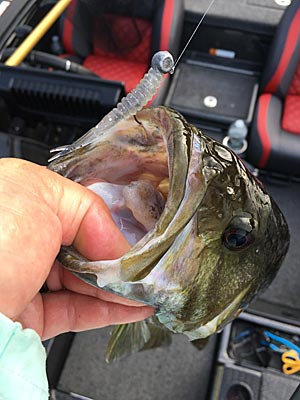
That Volunteer State tournament also was the national debut of the Damiki rig. And while it uses similar components, Mueller said Freestyling is different. It uses a lighter weight, has more action, and creates different profiles, depending on which soft-plastic lure you use. What they do share is spots.
The spots
Through autumn, schools of bass are on the move, feeding without pause as they transition to wintering holes. These destinations are usually deeper and warmer than the surrounding water, and the current is absent. And they’re always filled with baitfish. While slow metabolism from the cold water keeps bass from gorging, Mueller said they feed periodically throughout winter. But they don’t stay in schools.
Mueller’s most likely to find bass in groups of two or three. They often roam expansive and featureless deep-water flats; he fishes some as large as four football fields. They don’t suspend, preferring to be close to the bottom. Sometimes they’ll swim a few feet above it, he said, and other times, they’re so tight to it that there’s mud on their bellies, and they barely register on traditional 2-D sonar. So, he relies on the latest technology to find them.
Mueller’s bow-mounted Garmin electronics feature Panoptix LiveScope, which separates targets — such as bass and cover or bass and bottom — better than traditional sonar. Its transducer is mounted on his trolling motor, giving him a real-time view of what is happening 70 to 80 feet in whichever direction he points it. That setup proved key to unlocking his Elite Series win on Lanier. “I could count how many fish were in a brush pile,” he said. He also uses the unit’s LiveScope Down feature, which offers the same resolution — he often sees the strike before he feels it — to find cold-water bass along the bottom. When he sees one, he’ll troll over and drop his lure.
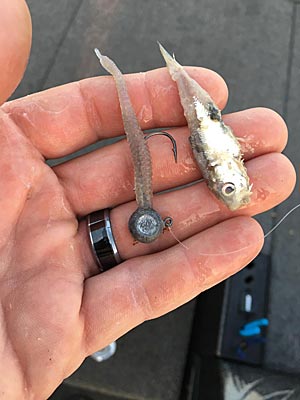
It’s hard to beat the efficiency of a vertical presentation. “That’s the ideal situation when you can get right over the fish,” Mueller said. And that’s what he does unless bass are boat-shy. They’re that way often in summer, when the almost endless whirling trolling motors, pinging electronics, and other topside noises repel them. He said those in less than 25 feet of water can behave the same way in winter. And if they do, he stays farther away and casts to them.
Even if you can sneak your boat close to the cold-water bass you’ve found, Mueller said you don’t want your jig under them. “You’re not fishing it on the bottom,” he said. “You’re fishing it above the fish.” Sometimes, he’ll pull away his Freestyling jig and soft plastic combo away, but not too far. “It’s like a video game,” he said. “When smallies are pressured, they get finicky. But you can still fool them. You can tick off a smallie into biting.”
The jig head
The Freestyling technique was born from Mueller’s ice fishing and pan fishing. It shares the same electronics, watching and imparting steady soft shakes to your lure, creating the most action with the slightest movement. He said his lure needs to quiver in place like an injured, struggling, or dying baitfish. Lightweight jigheads do that best, he said.
Mueller pours his jig heads using Do-It’s Freestyle jig mold. The company offers two versions, giving him a variety of hook sizes and weights to match conditions, especially wind speed and water depth. Most of the ones he uses in cold water weigh from 1/32 to 3/16 ounce. You want to use the lightest one that you can, he said. Those are easier to keep in front of bass, and when you’re casting it, he said it is less likely to pendulum back to you as it sinks.
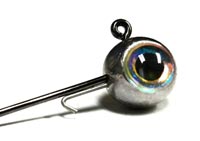
But more than a lack of weight makes these jigs unique. Mueller said at first glance, they resemble a traditional aspirin-shaped jig head. They differ in their sides, which are slightly rounded. “It also has a wire keeper, so all the weight is on the head,” he said. Those attributes create the all-important quivering action, he said.
The soft-plastic lures
The jig head is only part of the Freestyling technique. The soft-plastic lure he loads onto it plays an equally important role. Mueller said its size can be changed to match the mood of the bass he’s fishing for. He chooses from three.
Mueller often reaches for Reins’ 3-inch Bubbling Shaker when the water is at its coldest. He rigs it on a 3/32- or 1/8-ounce Freestyle jig head that sports a No. 1 hook. “I’ve caught more [cold-water] fish on them than anything else,” he said.

It’s essential to use the correct size hook, Mueller said. It must match the lure, so they can work together to create the most action. So, while a No. 1 hook best fits the Bubbling Shaker worm, it’s too large for the bait he turns to when bass get a bit more finicky — a small Rein’s Rockvibe Shad. It’s less than 2 inches long, so he matches it with a jig head weighing 3/32 ounce or less and a No. 6 hook.
Mueller can see on his electronics when bass are their most challenging to catch. They repeatedly swim up to his lure and then return to the bottom. He reserves Do-It Mold’s ES Crappie Fluke for them. He first saw it at a recent ICAST sportfishing equipment tradeshow. “Once I saw the size of it, I knew it was going to be incredible,” he said. While it was designed for panfish, he said it has already proved itself with big smallmouth in cold water.
The Crappie Fluke measures 2.5 inches. And when Mueller fishes it, he uses the same jig head as the Bubbling Shaker. But when fishing is at its toughest, he uses just its tail. Do-It sells a mold for it, allowing lure builders to pour one color of the tail to fuse onto a different color body. He rigs the tail on a jig head with a No. 6 hook. “Some days, a 3-inch bait may be too big,” he said.

Mueller said reservoir bass have winter diets that skew toward baitfish such as alewives. And those in natural lakes eat more panfish and perch. He’ll change the color of his soft plastics to match.
The outfit
Putting a lightweight Freestyle jig in front of a bass in deep, cold water is wrapped up in the line you use. So, Mueller chooses one with a small diameter. They cut through the water easier than large-diameter lines, whose extra width adds resistance, acting like a parachute and keeping smaller jigs shallower longer. He uses 5-pound test Gamma fluorocarbon for jigs up to 1/8 ounce.
Lines with small diameters, usually associated with lighter pound tests, also give lures more freedom to move. That allows Mueller to make his Freestyle jigs dance in place with only the slightest shakes of his rod tip. “I think the biggest mistake is overworking the bait,” he said. “It doesn’t take much to get the right action.”
Protecting light line from break-offs requires the right rod. Mueller uses a Dobyns Fury 661, which sports a slow-action tip. He matches it to a Lew’s Custom Pro Speed Spin 1000.
Mueller will step up to a 3/16-ounce jig head when the water is warmer, but the bass are still deep. He did that at the Elite Series tournament on Lanier, where he caught spotted bass between 45 and 50 feet deep, and the water temperature was in the 40s. He matches it to stronger line — 10-pound test Gamma Torque braid — and a short leader of 6-pound test Gamma fluorocarbon line. Spotted bass, like smallmouth, have a tough mouth. He said the braid has less stretch, giving him solid hook sets in the deep water that these hard fighters can’t throw.
BassResource may receive a portion of revenues if you make a purchase using a link above.


